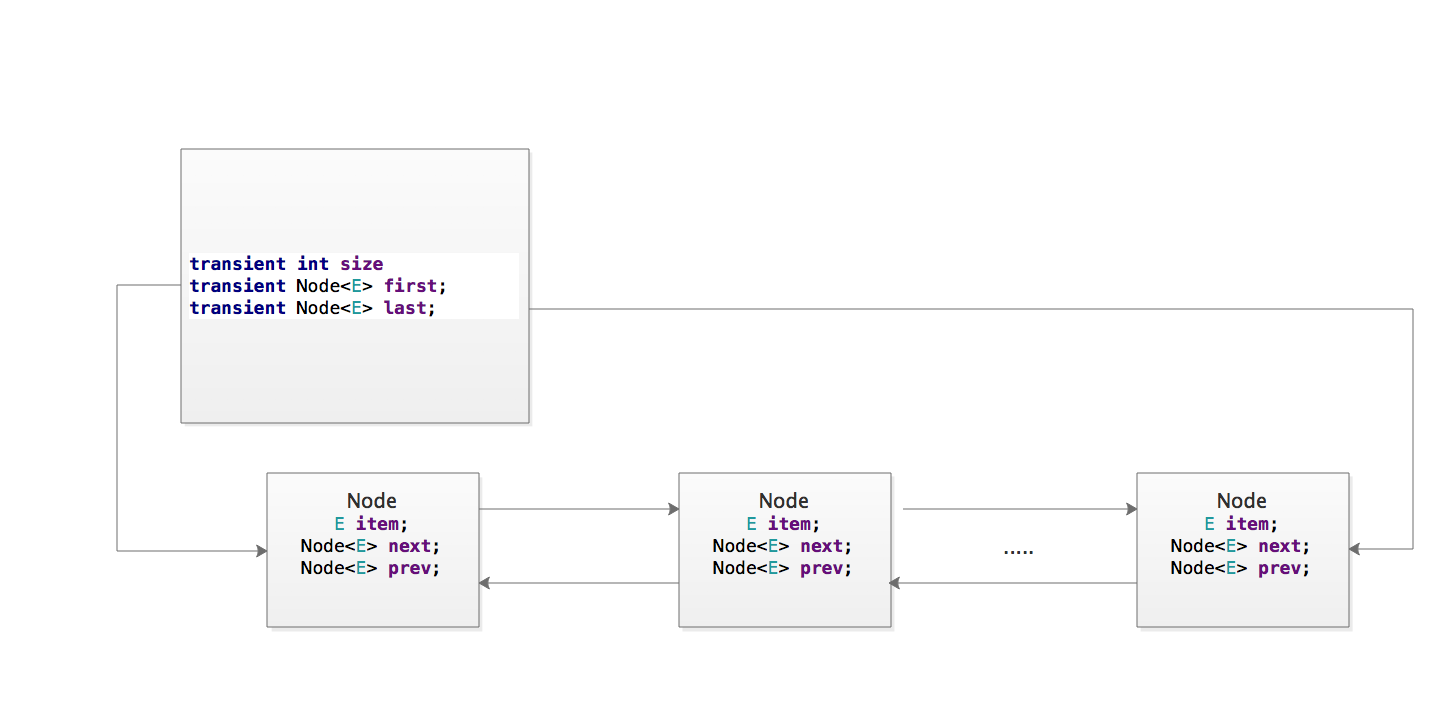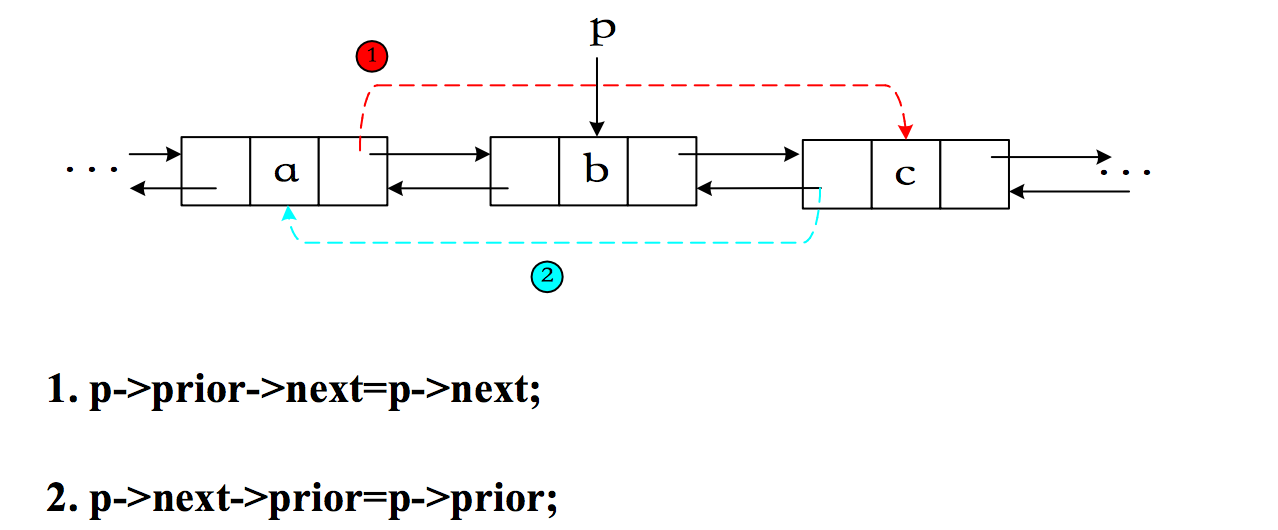java集合之LinkedList
一. LinkedList概述:
List 接口的链接列表实现。实现所有可选的列表操作,并且允许所有元素(包括 null)。除了实现 List 接口外,LinkedList 类还为在列表的开头及结尾 get、remove 和 insert 元素提供了统一的命名方法。这些操作允许将链接列表用作堆栈、队列或双端队列。
注意,此实现不是同步的。如果不存在这样的对象,则应该使用 Collections.synchronizedList 方法来“包装”该列表。最好在创建时完成这一操作,以防止对列表进行意外的不同步访问,如下所示:
List list = Collections.synchronizedList(new LinkedList(...));

public class LinkedList<E>
extends AbstractSequentialList<E>
implements List<E>, Deque<E>, Cloneable, java.io.Serializable
LinkedList 是一个继承于AbstractSequentialList的双向链表。它也可以被当作堆栈、队列或双端队列进行操作。
LinkedList 实现 List 接口,能对它进行队列操作。
LinkedList 实现 Deque 接口,即能将LinkedList当作双端队列使用。
LinkedList 实现了Cloneable接口,即覆盖了函数clone(),能克隆。
LinkedList 实现java.io.Serializable接口,这意味着LinkedList支持序列化,能通过序列化去传输。
LinkedList 是非同步的
二.LinkedList的用法 (参考优秀博文)
public class LinkedListTest {
public static void main(String[] args) {
// 测试LinkedList的API
testLinkedListAPIs() ;
// 将LinkedList当作 LIFO(后进先出)的堆栈
useLinkedListAsLIFO();
// 将LinkedList当作 FIFO(先进先出)的队列
useLinkedListAsFIFO();
}
/*
* 测试LinkedList中部分API
*/
private static void testLinkedListAPIs() {
String val = null;
//LinkedList llist;
//llist.offer("10");
// 新建一个LinkedList
LinkedList llist = new LinkedList();
//---- 添加操作 ----
// 依次添加1,2,3
llist.add("1");
llist.add("2");
llist.add("3");
// 将“4”添加到第一个位置
llist.add(1, "4");
System.out.println("\nTest \"addFirst(), removeFirst(), getFirst()\"");
// (01) 将“10”添加到第一个位置。 失败的话,抛出异常!
llist.addFirst("10");
System.out.println("llist:"+llist);
// (02) 将第一个元素删除。 失败的话,抛出异常!
System.out.println("llist.removeFirst():"+llist.removeFirst());
System.out.println("llist:"+llist);
// (03) 获取第一个元素。 失败的话,抛出异常!
System.out.println("llist.getFirst():"+llist.getFirst());
System.out.println("\nTest \"offerFirst(), pollFirst(), peekFirst()\"");
// (01) 将“10”添加到第一个位置。 返回true。
llist.offerFirst("10");
System.out.println("llist:"+llist);
// (02) 将第一个元素删除。 失败的话,返回null。
System.out.println("llist.pollFirst():"+llist.pollFirst());
System.out.println("llist:"+llist);
// (03) 获取第一个元素。 失败的话,返回null。
System.out.println("llist.peekFirst():"+llist.peekFirst());
System.out.println("\nTest \"addLast(), removeLast(), getLast()\"");
// (01) 将“20”添加到最后一个位置。 失败的话,抛出异常!
llist.addLast("20");
System.out.println("llist:"+llist);
// (02) 将最后一个元素删除。 失败的话,抛出异常!
System.out.println("llist.removeLast():"+llist.removeLast());
System.out.println("llist:"+llist);
// (03) 获取最后一个元素。 失败的话,抛出异常!
System.out.println("llist.getLast():"+llist.getLast());
System.out.println("\nTest \"offerLast(), pollLast(), peekLast()\"");
// (01) 将“20”添加到第一个位置。 返回true。
llist.offerLast("20");
System.out.println("llist:"+llist);
// (02) 将第一个元素删除。 失败的话,返回null。
System.out.println("llist.pollLast():"+llist.pollLast());
System.out.println("llist:"+llist);
// (03) 获取第一个元素。 失败的话,返回null。
System.out.println("llist.peekLast():"+llist.peekLast());
// 将第3个元素设置300。不建议在LinkedList中使用此操作,因为效率低!
llist.set(2, "300");
// 获取第3个元素。不建议在LinkedList中使用此操作,因为效率低!
System.out.println("\nget(3):"+llist.get(2));
// ---- toArray(T[] a) ----
// 将LinkedList转行为数组
String[] arr = (String[])llist.toArray(new String[0]);
for(String str:arr) {
System.out.println("str:"+str);
}
// 输出大小
System.out.println("size:"+llist.size());
// 清空LinkedList
llist.clear();
// 判断LinkedList是否为空
System.out.println("isEmpty():"+llist.isEmpty()+"\n");
}
/**
* 将LinkedList当作 LIFO(后进先出)的堆栈
*/
private static void useLinkedListAsLIFO() {
System.out.println("\nuseLinkedListAsLIFO");
// 新建一个LinkedList
LinkedList stack = new LinkedList();
// 将1,2,3,4添加到堆栈中
stack.push("1");
stack.push("2");
stack.push("3");
stack.push("4");
// 打印“栈”
System.out.println("stack:"+stack);
// 删除“栈顶元素”
System.out.println("stack.pop():"+stack.pop());
// 取出“栈顶元素”
System.out.println("stack.peek():"+stack.peek());
// 打印“栈”
System.out.println("stack:"+stack);
}
/**
* 将LinkedList当作 FIFO(先进先出)的队列
*/
private static void useLinkedListAsFIFO() {
System.out.println("\nuseLinkedListAsFIFO");
// 新建一个LinkedList
LinkedList queue = new LinkedList();
// 将10,20,30,40添加到队列。每次都是插入到末尾
queue.add("10");
queue.add("20");
queue.add("30");
queue.add("40");
// 打印“队列”
System.out.println("queue:"+queue);
// 删除(队列的第一个元素)
System.out.println("queue.remove():"+queue.remove());
// 读取(队列的第一个元素)
System.out.println("queue.element():"+queue.element());
// 打印“队列”
System.out.println("queue:"+queue);
}
三.源码解读
1.数据结构
LinkedList 是一个双向链表。内部类 Node 是 LinkedList 中的基本数据结构,包含当前节点值,上一个节点得引用,和下个节点的引用。
// 链表中有多少个节点,默认为 0
transient int size = 0;
// 头节点
transient Node<E> first;
// 尾节点
transient Node<E> last;
private static class Node<E> {
E item;
Node<E> next;
Node<E> prev;
Node(Node<E> prev, E element, Node<E> next) {
this.item = element;
this.next = next;
this.prev = prev;
}
}

2.构造方法
比较简单,默认无参构造,和一个 Collection 参数的构造( 将里面元素按顺序前后连接,修改节点个数,并且操作次数 + 1 )。
public LinkedList() {
}
/**
* Constructs a list containing the elements of the specified
* collection, in the order they are returned by the collection's
* iterator.
*
* @param c the collection whose elements are to be placed into this list
* @throws NullPointerException if the specified collection is null
*/
public LinkedList(Collection<? extends E> c) {
this();
addAll(c);
}
3.添加方法ADD
// 尾部插入
public boolean add(E e) {
// 去为节点加
linkLast(e);
return true;
}
// 将指定的元素防止在链表的尾节点,以前的尾节点变成它前面的节点,如果上个尾节点为null,说明以前是的空链表。
void linkLast(E e) {
final Node<E> l = last;
final Node<E> newNode = new Node<>(l, e, null);
last = newNode;
if (l == null)
first = newNode;
else
l.next = newNode;
// 添加一个,我们就需要把size增加
size++;
modCount++;
}
add(int index, E element)
public void add(int index, E element) {
// 边界校验
checkPositionIndex(index);
if (index == size)
linkLast(element);
else
linkBefore(element, node(index));
}
/**
* Returns the (non-null) Node at the specified element index.
*/
Node<E> node(int index) {
// assert isElementIndex(index);
// 双链表可以分别从 头节点 或者尾节点开始遍历,计算它是在前面一半,还是在后面的位置,决定遍历方式。
// 这也是LinkedList 为什么要使用双向链表,提升了使用游标操作链表的效率。
if (index < (size >> 1)) {
Node<E> x = first;
for (int i = 0; i < index; i++)
x = x.next;
return x;
} else {
Node<E> x = last;
for (int i = size - 1; i > index; i--)
x = x.prev;
return x;
}
}
/**
* Inserts element e before non-null Node succ.
*/
void linkBefore(E e, Node<E> succ) {
// assert succ != null;
final Node<E> pred = succ.prev;
final Node<E> newNode = new Node<>(pred, e, succ);
succ.prev = newNode;
if (pred == null)
first = newNode;
else
pred.next = newNode;
size++;
modCount++;
}
检查索引是否越界,虽然 ListedList 中没有索引概念;
如果 index 和 size 相同,则在尾节点上加上元素;
不相同的话,先去遍历链表查找到索引位置的节点,然后在它的前面插入节点。

1.s->prior=p->prior;
2. p->prior->next=s;
3. s->next=p;
4. p->prior=s;
4.获取元素Get
public E get(int index) {
// 检查索引越界;
// 跟上面的一样,查找该索引位置的节点,然后获取它的元素。
checkElementIndex(index);
return node(index).item;
}
5.删除元素Remove
public E remove() {
return removeFirst();
}
// 移除头节点
public E removeFirst() {
final Node<E> f = first;
if (f == null)
throw new NoSuchElementException();
return unlinkFirst(f);
}
// 参数 f 为头节点
// 将头节点指向 next 节点,如果 next节点 为 null 则链表 为 null ,链表大小减 1 ,修改次数记录加 1.
private E unlinkFirst(Node<E> f) {
// assert f == first && f != null;
final E element = f.item;
final Node<E> next = f.next;
f.item = null;
f.next = null; // help GC
first = next;
if (next == null)
last = null;
else
next.prev = null;
size--;
modCount++;
return element;
}
public E remove(int index) {
checkElementIndex(index);
return unlink(node(index));
}
/**
* Unlinks non-null node x.
*/
E unlink(Node<E> x) {
// assert x != null;
final E element = x.item;
final Node<E> next = x.next;
final Node<E> prev = x.prev;
// 如果本节点为头节点,头节点指向next
if (prev == null) {
first = next;
} else {
// 不是头节点,则将前节点和后节点连接起来,然后删掉本节点的引用 GC
prev.next = next;
x.prev = null;
}
// 如果是尾节点,则将尾节点指向前节点
if (next == null) {
last = prev;
} else {
// 连接,双向链表,双方都有引用,删除自身的引用GC
next.prev = prev;
x.next = null;
}
// 删除自身 GC
x.item = null;
size--;
modCount++;
return element;
}
// 遍历 equals 找出 node,然后调用 unlink(Node<E> x)
public boolean remove(Object o) {
if (o == null) {
for (Node<E> x = first; x != null; x = x.next) {
if (x.item == null) {
unlink(x);
return true;
}
}
} else {
for (Node<E> x = first; x != null; x = x.next) {
if (o.equals(x.item)) {
unlink(x);
return true;
}
}
}
return false;
}

6.更新元素Set
/**
*有索引,第一件事去检查索引是否越界;根据索引找出 node;
*替换 node 的元素,返回 该索引位置 Node 的旧元素的值。
*注意,Set 方法不增加LinkedList 的修改次数
*/
public E set(int index, E element) {
checkElementIndex(index);
Node<E> x = node(index);
E oldVal = x.item;
x.item = element;
return oldVal;
}
7.清空clear()
//释放所有的元素,让他们直接无引用,垃圾回收器发现这些 node 元素是不可达的时候,释放内存。
// 数据恢复默认;修改次数记录加一。
public void clear() {
// Clearing all of the links between nodes is "unnecessary", but:
// - helps a generational GC if the discarded nodes inhabit
// more than one generation
// - is sure to free memory even if there is a reachable Iterator
for (Node<E> x = first; x != null; ) {
Node<E> next = x.next;
x.item = null;
x.next = null;
x.prev = null;
x = next;
}
first = last = null;
size = 0;
modCount++;
}
四、ArrayList和LinkedList比较
-
ArrayList的实现是基于数组,LinkedList的实现是基于双向链表。
-
对于随机访问,ArrayList优于LinkedList
-
对于插入和删除操作,LinkedList优于ArrayList
-
LinkedList比ArrayList更占内存,因为LinkedList的节点除了存储数据,还存储了两个引用,一个指向前一个元素,一个指向后一个元素。
参考
https://blog.wuwii.com/java-linkedlist.html#more
https://www.cnblogs.com/skywang12345/p/3308807.html


 浙公网安备 33010602011771号
浙公网安备 33010602011771号